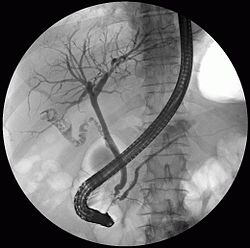Biliary system
| Bile duct | |
|---|---|

Digestive system diagram showing the bile duct
|
|

ERCP image showing the biliary tree and the main pancreatic duct.
|
|
| Details | |
| Identifiers | |
| Latin | ductus biliaris |
| TA | A05.8.02.013 |
| FMA | 9706 |
|
Anatomical terminology
[]
|
|
A bile duct is any of a number of long tube-like structures that carry bile.
Bile, required for the digestion of food, is secreted by the liver into passages that carry bile toward the hepatic duct, which joins with the cystic duct (carrying bile to and from the gallbladder) to form the common bile duct, which opens into the intestine.
The biliary tree (see below) is the whole network of various sized ducts branching through the liver.
The path is as follows: Bile canaliculi → Canals of Hering → interlobular bile ducts → intrahepatic bile ducts → left and right hepatic ducts merge to form → common hepatic duct exits liver and joins → cystic duct (from gall bladder) forming → common bile duct → joins with pancreatic duct → forming ampulla of Vater → enters duodenum
The bile duct is green like the gallbladder, because of bile stains.
Inflation of a balloon in the bile duct causes, through the vagus nerve, activation of the brain stem and the insular cortex, prefrontal cortex, and somatosensory cortex.
...
Wikipedia
